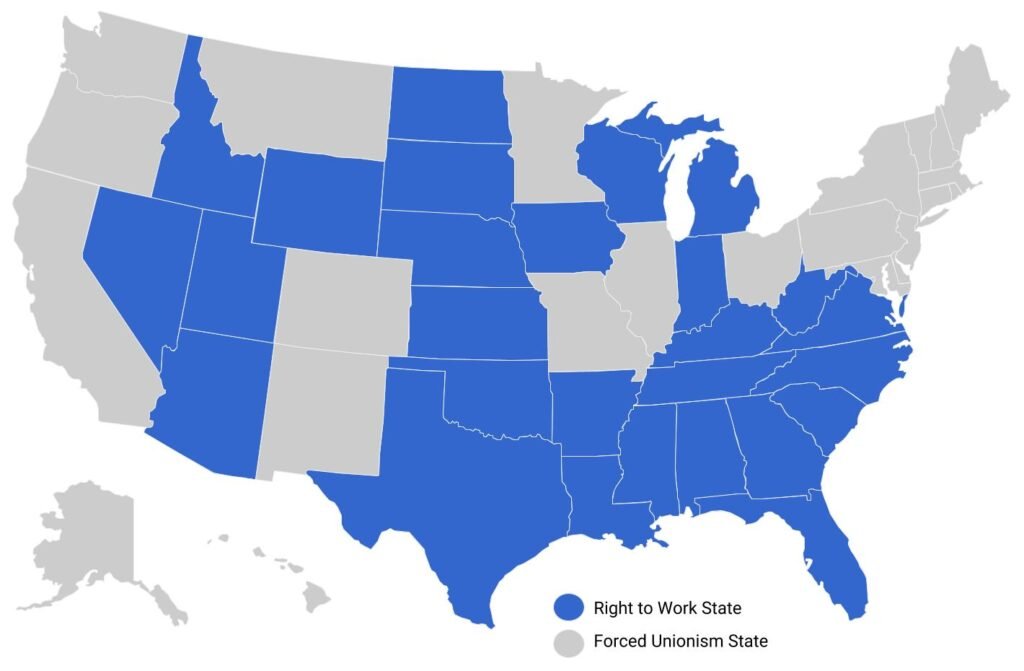Right to Work States in the USA Understanding Labor Laws and Implications
Labour laws and right to work states Introduction
Like all the countries in the United States, labor laws have long been a topic of contention and debate and it as deep rules and understanding to benefits the employee and employers. Among these, the concept of “Right to Work” has become a significant point of discussion in recent years. This article aims to provide a comprehensive understanding of Right to Work states in the US, exploring their history, implications, and effects on workers, businesses, and the economy.
What is a Right to Work State?
A Right to Work state is a region where employees are not required to join a labor union or pay union dues as a condition of their employment. These laws grant workers the right to choose whether or not to join a union, protecting their freedom of association and ensuring that employment decisions are not influenced by union membership.
History and Origins of Right to Work Laws
The roots of Right to Work laws can be traced back to the early 20th century when labor movements gained momentum in the US. Southern states, in particular, were concerned about the influence of powerful labor unions, leading to the emergence of legislation aimed at safeguarding individual worker rights.

Understanding the National Labor Relations Act (NLRA)
The National Labor Relations Act of 1935, also known as the Wagner Act, laid the foundation for collective bargaining and workers’ rights to unionize. However, it also allowed unions to require workers to become members or pay dues, leading to the need for Right to Work laws as a counterbalance.
The Taft-Hartley Act and its Impact on Right to Work Laws
In 1947, the Taft-Hartley Act was passed, amending the NLRA and providing states with the authority to pass Right to Work legislation. This act aimed to address concerns of compulsory unionization and promoted a balance between workers’ rights and union power.

Pros and Cons of Right to Work States
Right to Work laws have both proponents and critics. This section examines the advantages and disadvantages of these laws, touching upon economic, individual, and business perspectives.
Economic Impact of Right to Work Laws
One of the key debates surrounding Right to Work states is their impact on the economy. Here, we explore various studies and data that shed light on the economic consequences of these laws, including employment rates, wages, and business growth.
Collective Bargaining and Union Representation in Right to Work States
While Right to Work laws provide workers with the freedom to choose, they also influence collective bargaining and union representation dynamics. We delve into how these laws affect unions’ abilities to represent their members and negotiate with employers.
The Role of Right to Work Laws in Attracting Businesses
Right to Work states often market themselves as business-friendly environments. We examine the factors that attract businesses to these states and explore the connection between Right to Work laws and economic development.
Worker Rights and Protections in Right to Work States
Critics of Right to Work laws express concerns about potential impacts on worker rights. This section evaluates the rights and protections afforded to employees in these states and addresses whether such laws compromise worker well-being.
Debunking Myths About Right to Work Laws
Misconceptions and myths about Right to Work laws persist. We debunk common misconceptions and provide evidence-based insights to clarify the actual implications of these laws.
Right to Work vs. Union Security States: A Comparison
To better understand Right to Work states, we compare them to Union Security states, where union membership or payment of dues is compulsory. This comparison highlights the divergent approaches to labor relations in the US.
The Future of Right to Work Laws in the US
As the labor landscape continues to evolve, we explore the potential future of Right to Work laws, considering political, economic, and societal factors that could influence their trajectory.
Case Studies of Right to Work States
Examining specific Right to Work states in detail, we analyze their experiences and outcomes, offering valuable insights into the real-world effects of these laws.
Conclusion
Right to Work states in the US remain a significant aspect of labor law discussions. The balance between individual worker rights and collective representation continues to be a crucial consideration. As the country progresses, understanding the implications of Right to Work laws will be essential for shaping labor policies that cater to the needs of both workers and businesses.
FAQs
1. Do Right to Work laws completely eliminate unions?
No, Right to Work laws do not eliminate unions. They simply allow workers the freedom to choose whether or not to join a union.
2. Are Right to Work states more business-friendly?
Right to Work states often attract businesses due to perceived lower labor costs and flexibility in employment arrangements.
3. Do Right to Work laws lower wages for workers? The impact of Right to Work laws on wages is a subject of debate, with conflicting studies and data.
4. Can unions still negotiate on behalf of workers in Right to Work states?
Yes, unions can still negotiate and represent workers in Right to Work states, although their membership may not be mandatory.
5. How do Right to Work laws affect workers’ job security?
Right to Work laws do not directly impact job security, but critics argue that weaker unions may result in reduced job protections for workers.
Read more:
top 10 staffing companies in usa
More Corp to corp hotlist
Join linkedin 42000+ US Active recruiters Network
Join No.1 Telegram channel for daily US JOBS and Updated HOTLIST